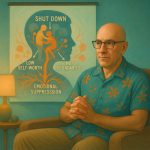Trauma doesn’t just live in memories. It lives in nervous systems, in relationship patterns, in how we show up—or shut down—with the people we love.
Trauma is passed down generation after generation. More than a personal wound, it becomes culture. Family legacy. Emotional DNA.
For anyone with a trauma history, the story that follows may feel familiar.
Meet Alex
Alex is in the midst of yet another breakup.
Despite having a kind heart and good intentions, he’s found himself unable to sustain relationships. He’s been married multiple times, and each time, the pattern repeats: initial closeness, then growing distance, misunderstandings, and eventually—separation.
Now, he finds himself distant not only from his former partners but also from his children, unsure how to bridge the gap. And, thanks to his low self-worth and fear of vulnerability, unwilling to try.
But wait—what trauma?
Alex doesn’t consider himself to be a trauma victim. But trauma doesn’t always show up as a single, dramatic event. Sometimes it’s the slow drip of emotional neglect. Sometimes it’s growing up in a household where feelings weren’t safe, or where connection was inconsistent. Sometimes, it’s what happens when well intentioned parents aren’t able to “be there” for their children.
Often, we don’t even realize we’ve been impacted—because what we experienced was “normal” — to us.
But our nervous systems remember.
And so do our relationships.
This Didn’t Start With Alex
His patterns aren’t mysteries. They’re the natural consequence of an emotional lineage that began long before he was born.
Alex didn’t land in this moment by accident.
His parents did their best.
But their best was shaped by what they survived—not by what they healed.
A Father Who Disappeared in Place
His father was physically present but emotionally absent.
Approval was rare. “I love you” never came.
What he offered instead were long evenings of television, obsessions with sports, and alcohol-fueled silence.
When life hurt, he numbed.
A Mother Who Equated Vulnerability with Danger
Alex’s mother praised performance.
She worked hard to keep him safe—but emotional safety was not part of the package.
She’d been raised in a world where vulnerability invited attack, and poverty meant hunger. Her survival depended on staying in control.
What Got Passed Down
So she passed on her survival strategy:
Stay in line.
Achieve.
Stay safe.
Don’t feel too much.
Don’t need too much.
And love? Love is something you earn. Over and over again.
What Alex Learned
He learned that:
Closeness isn’t safe
Vulnerability opens the door to abandonment or judgment
Affection is conditional—and approval fleeting
These lessons didn’t come in lectures.
They came in the silences.
In the way emotions were handled—or not handled—at home.
What Alex carries today isn’t his fault. It’s emotional inheritance.
The Part Most People Don’t Know
Most of what drives Alex’s adult behaviors was set long before he could even form memories.
The emotional system that governs attachment, fear, and connection is shaped in the earliest years of life—before the thinking brain is fully online.
The prefrontal cortex, which helps with self-awareness and decision-making, doesn’t even begin to mature until around age 7. Before that? The amygdala is in charge. That’s the part of the brain responsible for threat detection, emotional memory, and survival responses.
In other words: Alex’s shutdown response may have been shaped before he ever spoke a full sentence.
And because memory is language-based, it’s not unusual that he doesn’t remember why he reacts the way he does. The imprint is real—it’s just preverbal.
Patterns in the Present
AKA: The Closer He Gets, The More He Shuts Down
Like most of us, Alex wants intimacy.
But the closer he gets to it, the more his emotional inheritance kicks in—and quietly sabotages everything.
He doesn’t panic when someone gets too close.
He shuts down.
Subtly. Quietly. Completely.
And not just during conflict.
Even joy, tenderness, and peace feel unsafe.
His nervous system reads them as threats.
Those moments of emotional openness trigger something deep inside him: This is dangerous.
Doing Instead of Feeling
So, he throws himself into tasks.
He fixes things. He performs.
He shows love through doing—through devotion, duty, and responsibility.
It looks like connection.
It looks like love.
But it’s not intimacy.
It’s avoidance wearing a responsible man’s clothes.
The Cost of Overfunctioning
All that doing?
It leads to exhaustion, not closeness.
Exhaustion leads to resentment.
Resentment leads to shutdown.
His partner doesn’t understand what changed. But for Alex, nothing changed. This is just how it goes.
Never Enough, No Matter What He Does
He presses on, convinced that if he just does more, he’ll finally be good enough.
But no matter how much he gives, it never fills the void.
Because somewhere deep inside, Alex doesn’t believe he deserves love.
The Missing Skill: Boundaries
And nowhere along the way did anyone teach him how to set healthy boundaries.
Not with others.
Not with himself.
He’s not selfish.
He’s unpracticed.
And So the Cycle Continues
He does too much.
He burns out.
He withdraws.
His partner finally has enough—and leaves.
Wash. Rinse. Repeat.
These aren’t character flaws.
They’re survival strategies dressed up as personality traits.
They helped him once.
Now, they’re hurting the people he loves—and leaving him alone.
Zooming Out: Trauma’s Hidden Repetition
Alex’s story is specific—but not unique.
Many people with multigenerational trauma carry similar burdens into their relationships, shaped by:
Emotional suppression
Hypervigilance
Conflict avoidance or aggression
Fear of vulnerability
Distrust of closeness
Difficulty naming or asking for what they need
Low self-esteem
They may:
Express love through over-functioning and perfectionism
Shut down emotionally when things get “too good”
Repeat push-pull conflict patterns
Struggle with boundaries
Live with a sense of always being “too much” or “not enough”
These are not failures of character. They’re inherited survival strategies. But left unexamined, they don’t protect intimacy—they poison it.
Breaking the Cycle
This cycle isn’t passed down out of malice.
It’s passed down because it’s invisible.
Because it’s what we know.
Because it’s what we adapted to in order to survive.
Most of us aren’t aware of the impact our trauma has on how we love. We’re no more aware of it than we are of the air we breathe.
But just like breath, awareness changes everything.
The Power of Awareness
Mindfulness helps us notice when we’re holding our breath.
In the same way, it helps us notice when we’re repeating patterns that hurt us.
Awareness gives us space.
Space gives us choice.
And that’s how cycles break—not all at once, but one moment at a time.
Tiny Moments of Change
One moment of saying, “I’m shutting down—and I don’t want to.”
One moment of asking, “What do I actually need right now?”
One moment of setting a boundary, even when it feels terrifying
One moment of choosing to stay, to speak, to soften
Healing doesn’t erase the past. But it interrupts the transmission. It says: This pain stops with me.
Hope Is Contagious, Too
Just like trauma, healing is contagious.
When you show up differently in your relationships, others feel it.
When you name your needs and listen without armor, your children feel it.
When you model repair, softness, and vulnerability—people absorb it.
The most powerful legacy you can leave isn’t perfection. It’s awareness.
It’s the courage to face what you were never taught to face.
That’s how we stop handing trauma to the next generation.
That’s how we start handing down something better.




